Aggressive Inline Skates Purchasing Guide

Aggressive skating epitomizes artistic expression and creativity. The aggressive skates you opt for will significantly influence your blading journey. This guide pools a wealth of practical advice and tips to aid anyone in the market for new aggressive inline skates.
Overview
Overview
Determining the Right Size for Aggressive Inline Skates
When choosing the size for aggressive skates, remember not to simply select a size equivalent to your regular footwear. Use a tape measure to determine the precise length of your longer foot.
With an accurate foot length measurement, selecting the proper size becomes straightforward. Each model listed on our homepage is accompanied by a size guide, allowing you to match your foot length to the right size. These guides utilize millimeters, following the Mondopoint system to facilitate straightforward size conversion.
Steps to Measure Your Foot

- Stand on a solid, even surface.
- Wear the socks you plan to skate in.
- Place a sheet of paper against the wall.
- Ensure your heel is against the wall and your foot is on the paper.
- Mark the spot where your longest toe reaches.
- Measure from the wall or paper's edge to your mark.
- Repeat for both feet, using the larger measurement to determine your skate size.
The Perfect Fit for Aggressive Skates
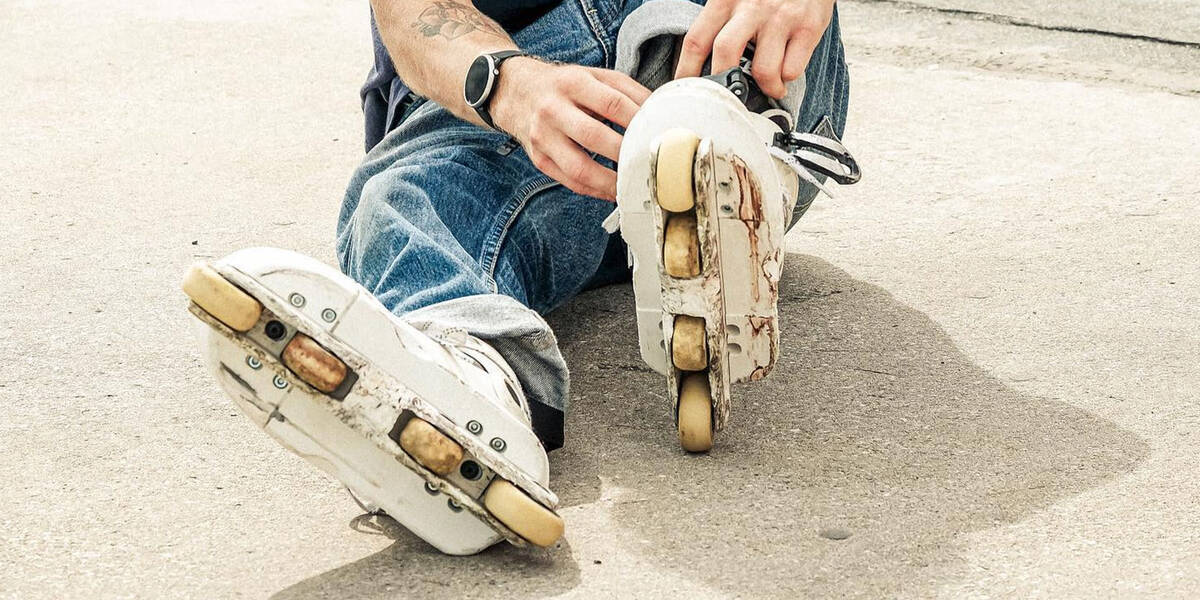
A proper fit for aggressive skates is snug around the feet, ensuring optimal control during tricks. Excess space in the boot could cause foot movement, leading to blisters and decreased control. Bulkier skates might add weight, complicating tricks.
In summary: Aim for a tight fit without causing discomfort, to achieve the best performance.
Breaking in Aggressive Skates
Initially, new aggressive skates might require some time to feel comfortable. Ensure they're snug, as the liner will conform to your foot's unique shape with time.
Here are some break-in tips for aggressive skates:
- Wear thick socks to minimize friction and avoid blisters.
- Break them in by wearing them during other activities.
- Start with shorter sessions and progressively extend them.
- Properly tighten laces and buckles to ensure comfort.
A standout feature of aggressive skates is the ability to replace worn liners with new ones, enhancing their lifespan.
The Anatomy of Aggressive Skates – What Defines Them?

- Boot: Hard boots or shells characterize aggressive skates.
- Frame: Sturdy frames withstand grinds and harsh landings.
- Wheels: Feature smaller wheels for enhanced control and stability.
- Soul plate: Extends your grind repertoire.
- H-block: Designed for grinding.
Aggressive skates excel in tricks, grinds, and jumps in urban settings and skateparks, turning everyday obstacles into trick opportunities. They're indisputably the top choice for grinding - no other skates are explicitly engineered for it.
Due to smaller wheels, aggressive skates lower the centre of gravity, making them easily controllable. While perfect for tricks, they may not be ideal for commutes, long-distance skating, urban skating at high speeds, or fitness-related skating, where larger wheels are preferable.
Selecting the Right Aggressive Skate Wheels

Crucial aspects of aggressive wheels include diameter, hardness, and profile. These attributes profoundly impact your skating experience.
Customize each element to align with your specific style and the most frequented terrain. This ensures you maximize your aggressive skating potential.
Diameter of Aggressive Skate Wheels
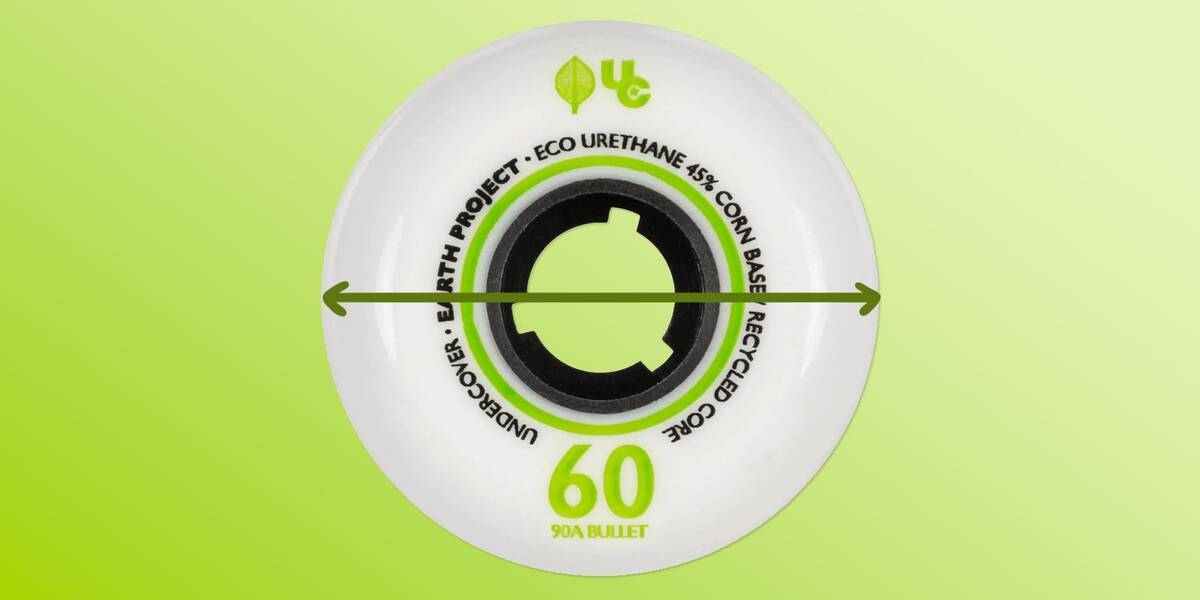
The usual diameter for aggressive skate wheels falls between 56-60 mm, but can range from 54 to 80 mm.
- Larger wheels (60-80 mm): Provide speed at the expense of stability, making technical tricks tougher.
- Smaller wheels (56-58 mm): Offer more stability, though slower speeds.
For standard wheel sizes in aggressive skates, skates equipped with 58 or 60 mm wheels are recommended.
Profile of Aggressive Skate Wheels

Aggressive inline wheels generally feature a flat profile, although some come with rounder or more pointed profiles.
- Flat profile: Provides stability, aiding in trick landings.
- Rounded profile: Increases agility but with less grip, lowering the chance of wheel snag on the rail.
- Pointy profile: Speeds up movement and eases turning due to decreased friction (not commonly used in aggressive skating).
For heavy trick usage, flat profile wheels are often recommended. Those seeking added speed and agility might consider a round profile.
Understanding Aggressive Skate Wheel Hardness
Measured on the durometer scale, the hardness of aggressive skate wheels typically ranges between 86A and 95A. Higher numbers indicate harder wheels.
- Harder wheels: Offer a faster roll on smooth surfaces but are less forgiving on rough ones, making slides easier while reducing wheel bite risks during grinds.
- Softer wheels: Improve stability, vibration dampening, and surface grip.
Consider the benefits and drawbacks of harder versus softer wheels on aggressive skates according to your personal riding style and preferences.
Wheel Configurations for Aggressive Skates
Aggressive skates are available with either a flat or anti-rocker wheel arrangement. These setups affect how the wheels align underneath and play a vital role in the riding experience, making them a key consideration when selecting aggressive inline skates.
Exploring Anti-Rocker Setups
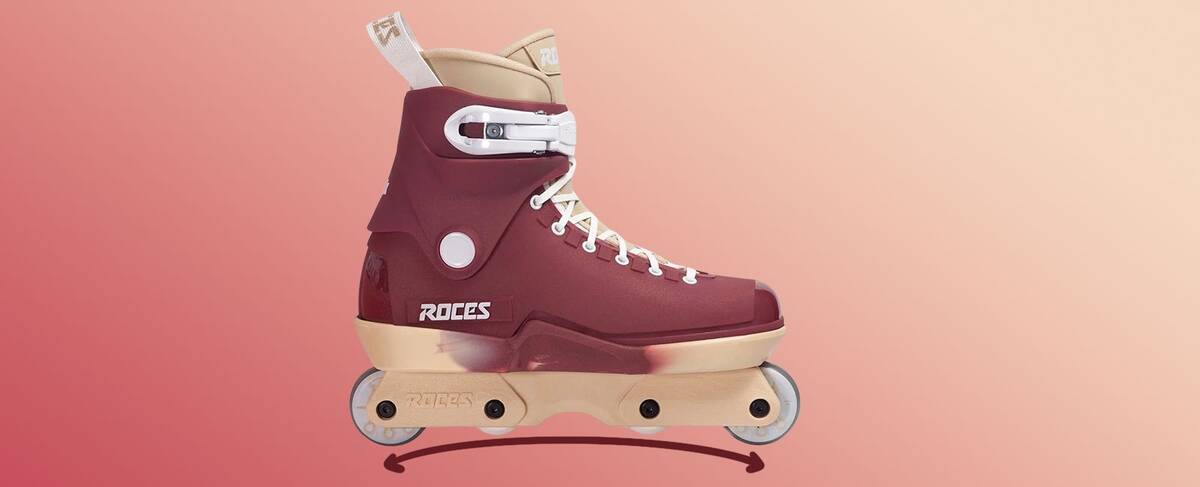
Anti-rocker arrangements have larger wheels at the front and back, with smaller middle wheels to facilitate grinding. These setups aren't as agile as flat configurations. Forming two contact points, the anti-rocker setup poses greater challenges when turning compared to flat or rocker setups. If the rigidity of an anti-rocker setup seems restrictive and you wish to prioritize grinds and aggressive skating, a flat wheel setup might be preferable.
What Are Anti-Rocker Wheels?
On aggressive inline skates with an anti-rocker setup, the two central wheels are anti-rocker wheels. They are usually smaller and harder than the side wheels and don’t contact the ground. They help in performing grinds without interfering, locking skaters into various grinds. Typically made from hard polyurethane, their non-stick nature enhances rail grinds.
The name "anti-rocker" refers to the wheels' reduced size, forming a raised gap between the ground and their base, unlike rocker setups where the outer wheels are slightly smaller than the central ones, enabling a rocking motion.
Is it Necessary for Anti-Rocker Wheels to Have Bearings?
While not essential for anti-rocker wheels, bearings can smoothen stair descents by facilitating rolling. Also known as grind wheels, their primary role is preventing wheel stickiness on rails during H-block grinds, thus bearings aren't obligatory. Some anti-rocker wheels include bearings, while others do not.
Explaining Flat Wheel Setups in Aggressive Skates
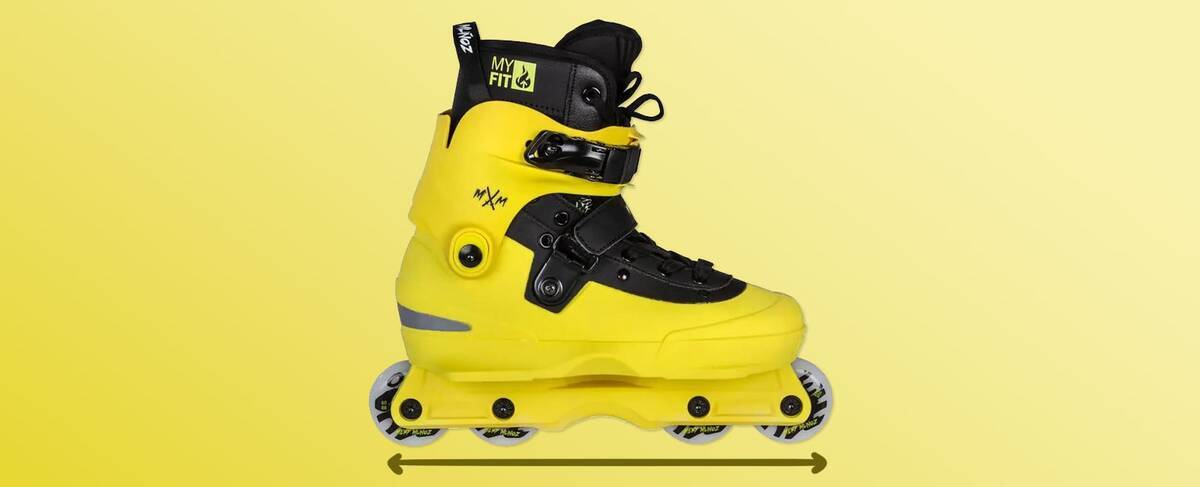
In flat configurations, all four wheels are identical in size, enhancing both speed and manoeuvrability compared to anti-rocker setups. However, flat setups require greater precision in groove grinds as there's a heightened risk of the middle wheels catching on the rail. Notably, not all frames support flat configurations, as they need adequate space for the middle wheels.
A flat setup is a solid suggestion for newcomers to inline skating who are eyeing aggressive skating. Numerous skilled aggressive skaters also favour flat setups for their style and challenge, requiring meticulous precision during H-block grinds.
Comparing Flat Setups and Anti-Rocker
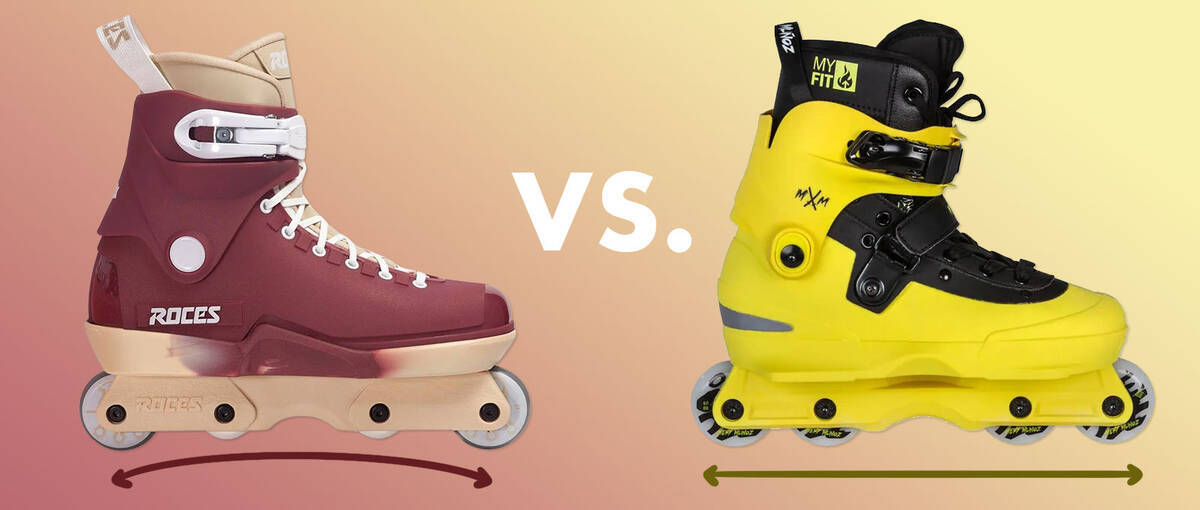
For skaters, be they novices or veterans, deciding between an anti-rocker or flat setup boils down to personal taste. There's no universally superior choice.
If you're uncertain about the configuration to opt for in new skates, consider the following:
- Anti-Rocker for Groove Grinds: Smaller anti-rocker wheels reduce H-block grind bites.
- Flat Setup for Groove Grinds: Grinds require more precision, offering potentially more stylish results.
- Speed: Flat setups outpace anti-rocker ones.
- Maneuverability: Turning with a flat setup can be smoother, enhancing bowl and park rides.
- Beginners on Inline Skates: Learning is easier on a flat setup.
- Beginners on Aggressive Skates: Anti-rocker setups ease grind learning. However, experienced inline skaters may prefer anti-rocker setups for easier grinding.
Your choice ultimately depends on your skating style and focus areas, whether you're just starting out with inline skates or already experienced and transitioning to aggressive skates.
Understanding Aggressive Skate Frames

Frames in aggressive skates primarily secure wheels and provide a grind platform. Given the centrality of grinding in this sport, choosing the right aggressive rollerblades hinges significantly on the frames.
Constructed from robust materials like aluminum, fiberglass, or composites, aggressive skate frames are durable enough to withstand intense skating. Most adhere to the Universal Frame System (UFS), ensuring they fit any aggressive boot brand.
Certain aggressive frames are crafted for a particular wheel arrangement, while others support numerous configurations. If your skates come with a flat wheel arrangement, it is possible to change them to an anti-rocker setup by fitting smaller wheels in the centre to boost your grinding capability.
Frames aren't universally compatible with a flat configuration, so altering from an anti-rocker to a flat setup necessitates careful thought. Measuring the space with a calliper can reveal if a conversion is possible, though reviewing the manufacturer's guidelines might be simpler. Confirm the frames can handle a flat setup, then inspect the maximum wheel size and select a set of eight wheels that fit within the maximum wheel diameter permitted by your frame.
Understanding the Universal Frame System
All frames using the UFS standard can be replaced with any other UFS frame, irrespective of the brand and dimensions.
Due to the nearly universal observance of the Universal Frame System (UFS), replacing worn frames is a straightforward task, which significantly helps in keeping your skates functioning optimally over time.
The Universal Frame System (UFS) is the standardized format for mounting frames and boots on aggressive skates. UFS allows for mixing and matching of boots and frames as per personal preference, allowing the creation of a customized aggressive skate setup. The process of changing frames on a UFS boot is uncomplicated, thanks to the agreement among aggressive skate manufacturers to adhere to this standard.
Details of the Universal Frame System (UFS)
- Distance Between Mounting Holes: 167mm
- UFS Mounting Hole Diameter: 20mm
- UFS Mounting Hole Depth: 3mm
- UFS Frame Width: 41mm
- Mounting: The frames are secured with two bolts inserted into the mounting holes
The bolt length for UFS varies among different frame designs. Although the distance between mounting holes is consistent across models, the frame lengths can vary, as UFS does not standardize this dimension.
Soulplates Explained

Soul plates are a signature element of aggressive skates, specifically designed to aid in grinding and shielding the skates from damage. Positioned between the frame and boot, soul plates are crafted from robust plastic materials.
These plates are vital to the skate's utility, facilitating smooth grinds on a variety of surfaces. The soul grind, often among the first grinds learners attempt, involves the foot nearest the rail gliding on the soul plate, while the other leg elongates forward and grinds on the H-block. A common initial hurdle for beginners is securing the soul plate to grip onto a curb or rail.
Bearings for Aggressive Skates
Bearings inside the wheels of aggressive skates play a crucial role in providing smooth rotation. Given the significant impacts intrinsic to aggressive skating, it's essential to routinely replace bearings to sustain superior performance in performing stunts. New bearings allow for a seamless roll, which is vital for executing tricks well. Replacement bearings are easily available for this purpose.
At SkatePro, bearings are categorized based on the ABEC scale, which rates them from 1 to 9 based on precision. Generally, a higher ABEC number indicates a smoother roll.
However, it’s important to understand that the ABEC rating does not reflect a bearing's durability. We advise selecting bearings from well-known brands rather than just focusing on the ABEC rating.
Are Aggressive Skates Suitable for Beginners?
If you are new to inline skating, aggressive skates are worth considering only if you aim to practice aggressive skating. For interests in fitness, freeride, marathons, or other inline sports, choosing a different skating type is advisable. However, for those leaning towards aggressive blading, starting with aggressive skates is recommended. Here's what to consider:
- Stability: The smaller wheels of aggressive skates provide more stability, a beneficial feature for beginners, as it simplifies learning the basics of inline skating.
- Terrain: Due to their smaller wheels and heavier design, aggressive skates are unsuitable for rough or uneven surfaces, limiting their use primarily to aggressive skating purposes.
- Flat Setup: Beginners should opt for aggressive skates with a flat wheel arrangement, meaning all eight wheels match in diameter. This setup facilitates the learning of basic strides and ensures a smooth rolling experience.
If you're unsure whether aggressive skates are right for you, consider learning more about various types of inline and roller skates:
-
<
